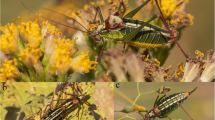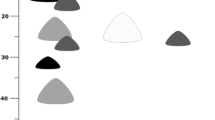Abstract
It has been generally thought that sex differences in the immune system are the result of the differing life history strategies of the sexes, although the available data are not entirely consistent with the hypothesis. In this study, we studied the variation in the immune function in the mound-building wood ant Formica exsecta. F. exsecta has two forms of males, distinguished by size: the small males (micraners) and the large males (macraners), which die after the mating period, whereas females live tens of years laying their eggs. We found that in general males have a lower encapsulation response against nylon monofilament (i.e. lower immune function) than queens. Among males, the micraners had a lower encapsulation rate than the macraners. However, in queens, there was no correlation between size and encapsulation rate. The origin nest had an effect on the encapsulation rate of males: males from the large nests had a stronger encapsulation rate than males from small nests. However, in queens, nest size did not have any effect on encapsulation response. The observed variation between sexes and individuals in the encapsulation rate is discussed in the context of reproductive strategies and parasite-mediated sexual selection.
Similar content being viewed by others
References
Acevedo-Whitehouse, K., Gulland, F., Greig, D. and Amos, W. (2003) Disease susceptibility in California sea lions: inbreeding in.uences the response of these animals to different pathogens in the wild. Nature 422, 35.
Adamo, S.A., Jensen, M. and Younger, M. (2001) Changes in lifetime immunocompetence in male and female Gryllus texensis (formely G. integer): trade-offs between immunity and reproduction. Anim. Behav. 62, 417–425.
Brown, W.D. and Keller, L. (2000) Colony sex ratios vary with queen number but not relatedness asymmetry in the ant Formica exsecta Proc. R. Soc. Lond. B 267, 1751–1757.
da Silva, C., Dunphy, G.B. and Rau, M.E. (2000) Interaction of hemocytes and prophenoloxidase system of fifth instar nymphs of Acheta domesticus with bacteria. Dev. Comp. Immunol. 24, 367–379.
Feder, D., Mello, C., Garcia, E. and Azambuja, P. (1997) Immune responses in Rhodnius prolixus: influence of nutrition and ecdysone. J. Insect Physiol. 43, 513–519.
Fisher, R.C. (1963) Oxygen requirements and the physiological suppression of supernumary insect parasitoids. J. Exp. Biol. 38, 605–658.
Folstad, I. and Karter, A. (1992) Parasites, bright males and the immunocompetence handicap. Am. Nat. 139, 603–622.
Fortelius, W., Pamilo, P., Rosengren, R. and Sundström, L. (1987) Male size dimorphism and alternative reproductive tactics in Formica exsecta ants (Hymenoptera, Formicidae). Ann. Zool. Fen. 24, 45–54.
Gillespie, J.P., Kanost, M.R. and Trenczek, T. (1997) Biological mediators of insect immunity. Annu. Rev. Entomol. 42, 611–643.
Gillespie, J.P. and Khachatourains, G.G. (1992) Characterization of Melanopplus sanguinipes after infection with Beauviria bassiana or wounding. Comp. Biochem. Physiol. B 103, 455–463.
Gray, D.A. (1998) Sex differences in susceptibility of house crickets, Acheta domesticus, to experimental infection with Serratia liquefaciens. J. Invertebr. Pathol. 71, 288–289.
Hölldobler, B. and Wilson, E.O. (1990) The Ants. The Belknap Press of Harward University Press Cambridge, Massaachusetts.
König, C. and Schmid-Hempel (1995) Foraging activity and immunocompetence in workers of the bumblebee, Bombus terrestris L. Proc. R. Soc. Lond. B 260, 225–227.
Koskimäki, J., Rantala, M.J., Suhonen, J., Taskinen, J. and Tynkkynen, K. (in press) Immunocompetence and resource holding potential in the damselfly Calopteryx virgo L. Behav. Ecol.
Kurtz, J. and Sauer, K. (2001) Gender differences in phenoloxidase activity of Panorpa vulgaris hemocytes. J. Invertbr. Pathol. 78, 53–55.
Kurtz, J., Wiesner, A., Götz, P. and Sauer, K. (2000) Gender differences and individual variation in the immune system of the Scorpionfly Panorpa vulgaris (Insecta: Mecoptera). Dev. Comp. Immunol. 24, 1–12.
Møller, A.P., Christe, P. and Lux, E. (1999) Parasitism, host immune function, and sexual selection. Q. Rev. Biol. 74, 3–20.
Møller, A.P., Sorci, G. and Erritzøe (1998) Sexual dimorphism in immune defense. Am. Nat. 152, 605–619.
Nappi, A.J., Vass, E., Frey, F. and Carton, Y. (1995) Superoxidase anion generation in Drosophila during melanotic encapsulation of parasites. Eur. J. Cell. Biol. 68, 450–456.
Nigam, Y., Maudlin, I., Welburn, S. and Ratcliffe, N.A. (1997) Detection of phenoloxidase activity in the hemolymph of tsetse flies, refractory and susceptible to infection with Trypanosoma brucei rhodesience. J. Invertebr. Pathol. 69, 279–281.
Nijhout, H. (1994) Insect Hormones. Princeton University Press.
Pamilo, P. (1991) Life span of queens in the ant Formica exsecta. Ins. Soc. 38, 111–119.
Pamilo, P. and Rosengren, R. (1983) Sex-ratio strategies in formica ants. Oikos 40, 24–35.
Poulin, R. (1996) Sexual inequalities in helminth infections: a cost of being male? Am. Nat. 147, 287–295.
Radhika, M., Nazar, A.K.A., Munuswamy, N. and Nellaiappan, K. (1998) Sex-linked differences in phenoloxidase in the fairy shrimp Streptocephalus dichotomus Baird and their possible role (Crustacea: Anostraca). Hydrobiologia 377, 161–164.
Rantala, M.J., Jokinen, I., Kortet, R., Vainikka, A. and Suhonen, J. (2002) Do pheromones reveal male immunocompetence? Proc. R. Soc. Lond. B 269, 1681–1685.
Rantala, M.J. and Kortet, R. (2003) Courtship song and immune function in the field cricket Gryllus bimaculatus? Biol. J. Linn. Soc. 79, 503–510.
Rantala, M.J. and Kortet, R. (in press) Male dominance and immunocompetence in a field cricket. Behav. Ecol.
Rantala, M.J., Kortet, R., Kotiaho, J.S., Vainikka, A. and Suhonen, J. (2003) Condition dependence of pheromones and immune function in the grain beetle Tenebrio molitor. Func. Ecol. 17, 534–540.
Rantala, M.J., Kortet, R. and Vainikka, A. (2003) The role of juvenile hormone in immune function and pheromone production trade-offs: a test of the immunocompetence handicap principle. Proc. R. Soc. Lond. B 270, 2257–2261.
Rantala, M.J., Koskimäki, J., Taskinen, J., Tynkkynen, K. and Suhonen, J. (2000) Immunocompetence, developmental stability and wing spot size in the damselfly Calopteryx splendens L. Proc. R. Soc. Lond. B 267, 2453–2457.
Ratcliffe, N.A. (1993) Cellular defence responses of insects: unresolved problems. In N.E. Beckage, S.N. Thompson and B.A. Federici (eds) Parasites and Pathogens of Insects. Academic Press, London, pp. 267–304.
Rheins, L.A. and Karp, R.D. (1985) Effect of gender on the inducible humoral immune response to honeybee venom in the American cockroach (Periplaneta americana). Dev. Comp. Immunol. 9, 41–49.
Rolff, J. (2001) Effects of age and gender on immune function of dragonflies (Odonata: Lestidea) from a wild population. Can. J. Zool. 79, 2176–2180.
Rolff, J. (2002) Bateman's principle and immunity. Proc. R. Soc. Lond. B 269, 867–872.
Ryder, J. and Siva-Jothy, M.T. (2000) Male calling song provides a reliable signal of immune function in a cricket. Proc. R. Soc. Lond. B 263, 1171–1175.
Sheldon, B. and Verhulst, S. (1996) Ecological immunology: costly parasite defences and trade-offs in evolutionary ecology. Trends Ecol. Evol. 11, 317–321.
Sheridan, L.A.D., Poulin, R., Ward, D.F. and Zuk, M. (2000) Sex differences in parasitic infections among arthropod hosts: is there a male bias? Oikos 88, 327–334.
Siva-Jothy, M.T. (2000) A mechanistic link between parasite resistance and expression of a sexually selected trait in a damselfly. Proc. R. Soc. Lond. B 267, 2523–2527.
Siva-Jothy, M.T. and Thompson, J.J.W. (2002) Short-term nutrient deprivation affects immune function. Physiol. Entomol. 27, 206–212.
Siva-Jothy, M.T., Tsubaki, Y., Hooper, R. and Plaistow, S.J. (2001) Investement in immune function under chronic and acute immune challenge in an insect. Physiol. Entomol. 26, 1–5.
Suwanchaichinda, C. and Paskewitz, S.M. (1998) Effects of larval nutrition, adult body size, and adult temperature on the ability of Anopheles gambiae (Diptera: Culicidae) to melanize sephadex beads. J. Med. Ent. 35, 157–161.
Trivers, R.L. (1972) Parental investment and sexual selection. In B. Cambell (ed.) Sexual Selection and the Descent of Man, 1871–1971. Aldine Press, Chicago, IL, USA, pp. 136–175.
Washburn, J.O., Kirkpatrick, B.A. and Volkman, L.E. (1996) Insect protection against viruses. Nature 383, 767.
Webb, B.A. and Luckhart, A.S. (1996) Factors mediating short-and longterm immunesuppression in parasitised insect. J. Insect Physiol. 42, 33–40.
Wedekind, C. and Folstad, I. (1994) Adaptive or nonadaptive immune suppression by sex hormones? Am. Nat. 143, 936–938.
Yourth, C.P., Forber, M. and Smith, B.P. (2001) On understanding variation in immune expression of the damselflies Lestes spp. Can. J. Zool. 79, 815–821.
Zuk, M. and McKean, K.A. (1996) Sex differences in parasite infections: patterns and processes. Int. J. Parasitol. 26, 1009–10024.
Zuk, M. and Stoehr, A.M. (2002) Immune defense and host life history. Am. Nat. 160, S9–S22.
Author information
Authors and Affiliations
Corresponding author
Rights and permissions
About this article
Cite this article
Vainio, L., Hakkarainen, H., Rantala, M.J. et al. Individual variation in immune function in the ant Formica exsecta; effects of the nest, body size and sex. Evolutionary Ecology 18, 75–84 (2004). https://doi.org/10.1023/B:EVEC.0000017726.73906.b2
Issue Date:
DOI: https://doi.org/10.1023/B:EVEC.0000017726.73906.b2




